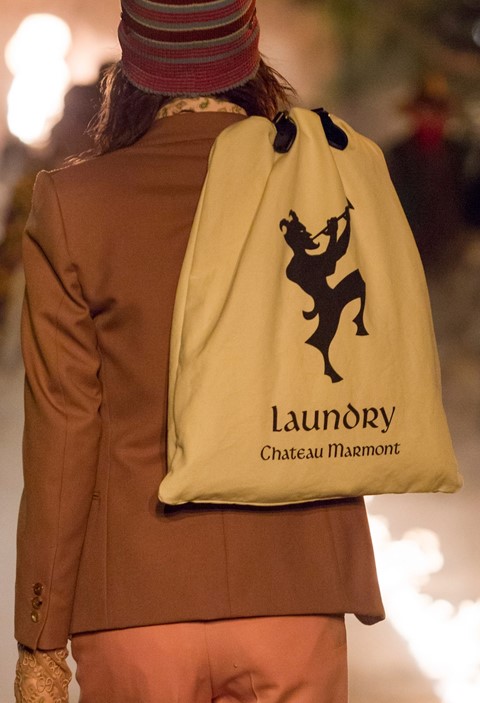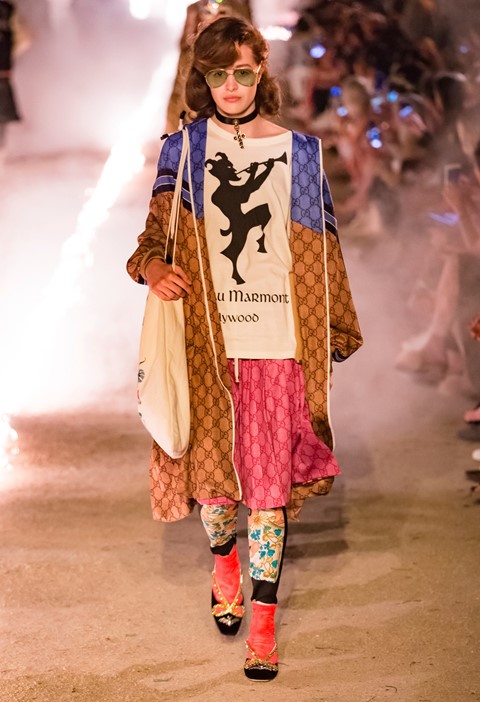A temple to debauched Hollywood, the Chateau Marmont has long wielded power over pop culture – now, thanks to Alessandro Michele’s Gucci, it’s making its mark on fashion, too
“If you must get in trouble, do it at the Marmont,” Harry Cohn, the then-director of Columbia Pictures, purportedly told two of his raptured young starlets sometime in Hollywood’s bygone era. Whether this is true or not, his directive has stuck – the Chateau Marmont, first built in the 1920s on Los Angeles’ Sunset Boulevard, is not just a hotel but a temple to the debauched, and a movie star’s playroom.
If it is said Los Angeles does not have history, then it at least has folklore (of the Hollywood variety) to make up for it – much of which circulates around the Chauteau’s hallowed hallways and bungalows, or the low-lit Bar Marmont. You probably know some of its stories already: there, James Dean jumped through a window to audition for Rebel Without a Cause; Sunset Boulevard was dreamt up on the premises; Led Zeppelin drove their motorcycles through the lobby. My own generation will know it for turn-of-millenium excess, and one particularly hedonistic guest, Lindsay Lohan, who took Cohn’s advice particularly to heart: she was removed from the premises for failing to pay her $46,350.04 tab. The Chateau, as it is affectionately known to residents, wears scandal like a badge of honour.

It makes for a sacred place of pop culture indeed – if movie stars were to ever stop returning to its rooms (for now, they show no signs of abating), then it is a ready-made museum of Hollywood, past and present. It already feels a little like one in the hotel’s reverential hush, and the feeling you are somehow surrounded like potential artefacts: bath towels may have once been used, several washes ago, by Courtney Love or Rick Rubin; your bed may have been slept in by Greta Garbo, or Elizabeth Taylor; soap dishes, wine glasses and pillows all have a potential tale to tell. (Many of the fixtures from its initial incarnation remained after it was renovated.)
Earlier this month, far across the world, Alessandro Michele showed his Cruise 2019 collection for Gucci in Alyscamps, a Roman necropolis – later, a Christian burial ground, later still a UNESCO heritage site – in Arles, France. There, among a typically eclectic collection, not restrained to luminous pink flares, dangerously studded bags and jewellery shaped like the torso of a skeleton (not to mention the billowing bride, in white, who closed the show) was the logo of the Chateau Marmont, printed on sweatshirts and written across ladylike leather bags. Michele is, after all, a disciple of pop culture and not immune to the sway of old Hollywood – his glittering halo of stars for Lana Del Rey at this year’s Grammys was based on a headpiece for the legendary Hedy Lamarr. It is in his blood, too: Michele’s mother worked on an Italian movie set, and his previous A/W18 show was an ode to her, and the magic of cinema, with its prosthetic dragon puppies and severed heads.

In the cruise show’s accompanying notes, the collection was describes as thus: “Widows attending grave sites, kids playing rock ’n’ roll stars, and ladies who aren’t ladies,” and the location itself spoke of the dead, and the way we remember those dead. The Chateau knows the dead well – John Belushi died in Bungalow Three of an overdose; Helmut Newton passed away after a car crash just off the premises. Ghosts, it is said, wander the hallways. One look in the collection was emblazoned with “Memento Mori”, a reference to objects kept to remember those who have passed and the hotel’s logo was alchemised within this narrative. The final appearance of the logo came on another bag, this time fashioned like the laundry sacks found in the hotel’s rooms. In Michele’s hands it became a sacred relic: a symbol of Hollywood, of its dirty laundry.
But Michele might have called upon the spirits of of the Chateau in another way entirely: its regard for taking in outsiders, from escaping Europeans seeking solace in a hedonistic and newly-built city, to the eccentric residents Greta Garbo and Howard Hughes who stayed there isolated for weeks on end. On the evening of the show, Gucci’s Instagram stories were taken over by Harris Reed, a young designer who made his name with flamboyant, glam rock-meets-Victoriana clothing for men. (Approval by Harry Styles has ensured a recent upshot in renown.) His own personal appearance – he stands over six foot, with chest-length hair and a propensity for silk and flares – and his defiantly “fluid” clothing may have at one time made him an outsider. In Michele’s world he is anything but: later in the evening, he would take to Gucci’s catwalk.
“It is the highest compliment to be a part of a brand that pioneers true creativity, self-expression and utter individuality,” Reed said on his own Instagram afterwards. “Alessandro has created a space for everyone to feel beautiful, strong, and frankly unstoppable.”
